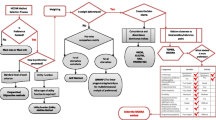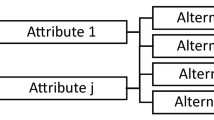Abstract
Performance efficiency of educational institutions should be constantly scrutinized and improved to make sure that competent manpower and researchers are produced proficiently in meeting the institutional standard of intellectuals. With a systematic performance evaluation system, resources can be directed satisfactorily and tasks may be completed effectively. Performance evaluation and ranking of engineering departments of technical institutions have received very limited attention due to complexity and difficulty in measuring the outputs. However, in today’s global education system, performance evaluation of engineering departments is required to assess whether they meet the set objectives and foster an environment of continuous improvement. So, the objective of this paper is set to develop a multi-criteria decision-making framework for performance evaluation and ranking of 16 engineering departments in an Indian university which addresses the inter-relationships between the selection criteria with the aid of decision-making trial and evaluation laboratory (DEMATEL) method while building a relationship structure. Entropy method is used to determine the relative criteria weights, and finally, a compromise ranking method is applied to prioritize and rank those departments. It is observed that Electrical Engineering department emerges out as the best performer and Information Technology department lags behind in its performance. Based on analytical results, faculty/student ratio, infrastructural development, student results and international research publications are identified to play major roles in evaluating the performance of those departments. This integrated model can help practitioners to improve their decision-making process, especially when criteria are numerous and interrelated. Its relevance and implementation issues in context of Indian engineering education scenario are also discussed.






Similar content being viewed by others
References
Agasisti, T., Catalano, G., Landoni, P., Verganti, R.: Evaluating the performance of academic departments: an analysis of research-related output efficiency. Res. Eval. 21(1), 2–14 (2012)
Agha, S.R., Kuhail, I., Abdelnabi, N., Salem, M., Ghanim, A.: Assessment of academic department’s efficiency using data envelopment analysis. J. Ind. Eng. Manag. 4(2), 301–325 (2011)
Al-Shayea, A.S., Battal, A.H.: Evaluating the efficiency of faculties in Qassim University using data envelopment analysis. J. Bus. Adm. Educ. 4/2, 132–138 (2013)
Al-Turki, U., Duffaa, S.: Performance measures for academic departments. Int J Educ Manag 17/7, 330–338 (2003)
Alwadood, Z., Mohd Noor N., Kamarudin, M.F.: Performance measure of academic departments using data envelopment analysis. Proc. IEEE Symposium on Business, Engineering and Industrial Applications, Malaysia, 395–399 (2011)
Aziz, N.A.A., Janor, R.M., Mahadi, R.: Comparative departmental efficiency analysis within a university: a DEA approach. Procedia Soc. Behav. Sci. 90, 540–548 (2013)
Budget Report. Jadavpur University Press (2012)
Carrington, R., Coelli, T., Rao, D.S.P.: The performance of Australian universities: conceptual issue and preliminary results. Econ. Pap. 24, 145–163 (2005)
Chen, Y.-C., Lien, H.-P., Tzeng, G.-H.: Measures and evaluation for environment watershed plans using a novel hybrid MCDM model. Expert Syst. Appl. 37/2, 926–938 (2009)
Derlacz, J.W., Parteka, A.: Efficiency of European public higher education institutions: a two-stage multicountry approach. Scientometrics 89/3, 887–917 (2011)
Fontela, E., Gabus, A.: The DEMATEL Observer. DEMATEL 1976 Report. Battelle Geneva Research Center, Switzerland (1976)
Gabus, A., Fontela, E.: Perceptions of the World Problematique: Communication Procedure, Communicating with Those Bearing Collective Responsibility. DEMATEL Report No. 1. Battelle Geneva Research Center, Geneva (1973)
Hamidi, N., Yousefi, P., Rahimi, A., Jabari, F.: A hybrid of Borda and DEMTEL for productivity improvement. Manag. Sci. Lett. 2, 2757–2764 (2012)
http://en.wikipedia.org/wiki/Jadavpur_University. Retrieved on 10/01/2014
http://www.jaduniv.edu.in/view_department.php. Retrieved on 12/01/2014
http://www.juresultdirectory.org/default.asp. Retrieved on 14/01/2014
Hwang, C.L., Yoon, K.: Multiple Attribute Decision Making Methods and Applications. Springer Verlag, Berlin (1981)
Kao, C., Hung, H.T.: Efficiency analysis of university departments: an empirical study. Omega 36/4, 653–664 (2008)
Köksal, G., Nalçaci, B.: The relative efficiency of departments at a Turkish engineering college: a data envelopment analysis. High. Educ. 51/2, 173–189 (2006)
Lal, A., De, R.P., Sen, A.: The Lamp in the Lotus: A History of Jadavpur University. Jadavpur University Press, Calcutta (2005)
Lopes, A.L.M., Lanzer, E.A.: Data envelopment analysis-DEA and fuzzy sets to assess the performance of an academic departments: a case study at a Federal University of Santa Catarina UFSC. Pesqui. Operacional 22/2, 217–230 (2002)
Martín, E.: Efficiency and quality in the current higher education context in Europe: an application of the data envelopment analysis methodology to performance assessment of departments within the University of Zaragoza. Qual. High. Educ. 12/1, 57–79 (2006)
Mukherjee, H., Mukherjee, U.: The Origins of the National Education Movement. National Council of Education, Calcutta (1992)
Olson, K., Vu, L.: Economic efficiency in farm households: trends, explanatory factors, and estimation methods. Agric. Econ. 40, 587–599 (2009)
Opricovic, S., Tzeng, G.H.: Compromise solution by MCDM methods: a comparative analysis of VIKOR and TOPSIS. Eur. J. Oper. Res. 156, 445–455 (2004)
Opricovic, S., Tzeng, G.H.: Extended VIKOR method in comparison with outranking methods. Eur. J. Oper. Res. 178, 514–529 (2007)
Prathap, G., Gupta, B.M.: Ranking of Indian engineering and technological institutes for their research performance during 1999–2008. Curr. Sci. 97, 304–306 (2009)
Rayenim, M.M., Saljooghi, F.H.: Benchmarking in the academic departments using data envelopment analysis. Am. J. Appl. Sci. 7/11, 1464–1469 (2010)
Sengupta, S.: Skills gap hurts technology boom in India. The New York Times. 17 October (2006)
Tamura, H., Akazawa, K.: Structural modeling and systems analysis of uneasy factors for realizing safe, secure and reliable society. J. Telecommun. Inf. Technol. 3, 64–72 (2005)
Tauer, L.W., Fried, H.O., Fry, W.E.: Measuring of academic departments within a college. Educ. Econ. 15, 473–489 (2007)
Tyagi, P., Yadav, S.P., Singh, S.P.: Relative performance of academic departments using DEA with sensitivity analysis. Eval. Program Plan. 32/2, 168–177 (2009)
Author information
Authors and Affiliations
Corresponding author
Rights and permissions
About this article
Cite this article
Ranjan, R., Chatterjee, P. & Chakraborty, S. Evaluating performance of engineering departments in an Indian University using DEMATEL and compromise ranking methods. OPSEARCH 52, 307–328 (2015). https://doi.org/10.1007/s12597-014-0186-1
Accepted:
Published:
Issue Date:
DOI: https://doi.org/10.1007/s12597-014-0186-1




